Madness
When minimum standards drift into absurdity…
One of the major benefits of private vessels, other than the fact that no one else can use them, is that they aren’t beholden to the same rigorous standards that commercial vessels are. As a result, there is more flexibility and freedom to design a vessel as the buyer so desires, as well as crucially increasing the opportunity for certain systems, technologies and protocols to be omitted as a means of cost-saving. However, at what point do the realms of legality & acceptance become so confused that stakeholders are willing to overlook common sense? Herein we explore, using a case study, the issue of fire safety onboard private vessels.
The GAs presented in this article are for two similar vessels, both sub-500gt and both within a similar price range, one is private and one is commercial. Where the two vessels do differ, however, is in their incomparable levels of fire safety. It should be noted at this juncture, that the critical element of this article is not targeted at shipyards or particular designs, it is merely to highlight the options that are available to owners.
An industry peer once described the conundrum in the following way:
When choosing whether or not to build to commercial or private standard it is like walking into a car dealership and being presented with two options, both of which look the same. The first option has been designed to be used as a taxi and as a result, it has better steering, better breaks, better airbags and better seatbelts. When it comes to safety, this option has better everything, but it costs more. The other option is for the non-taxi version, which has none of the additional benefits or high safety standards. Often people choose the non-taxi version (private), regardless of the fact that the taxi version does not have to be operated as such.
This, he explains, is mad.
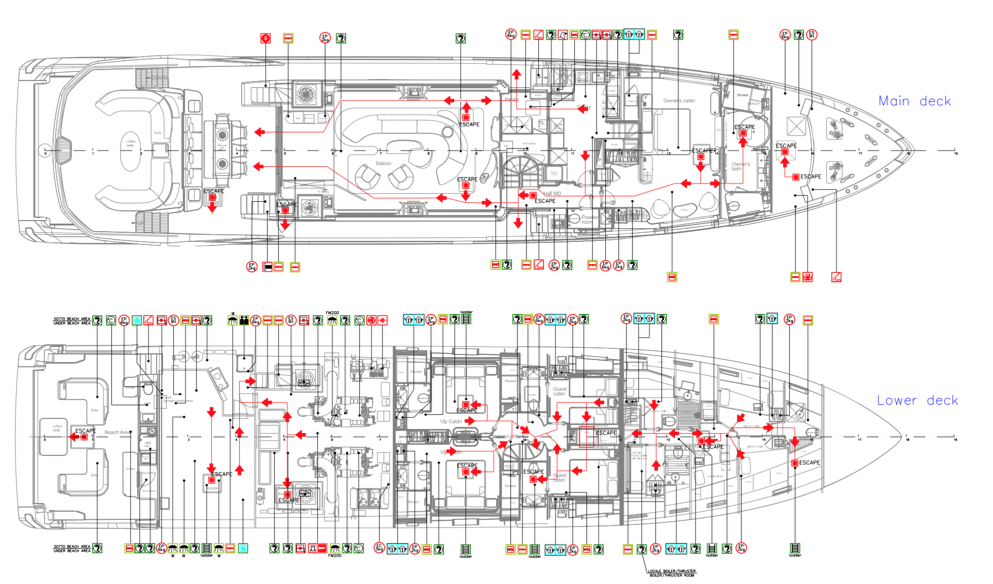
If we consider the above GA for the private vessel; it has no fire boundaries, including for the engine room and galley; there is no fixed firefighting system in the accommodation; and no fire treatment for soft furnishings and hanging material. The conclusion from the risk assessment is that this vessel represents a substantial risk of fire rapidly spreading throughout the yacht – albeit a perfectly legal superyacht.
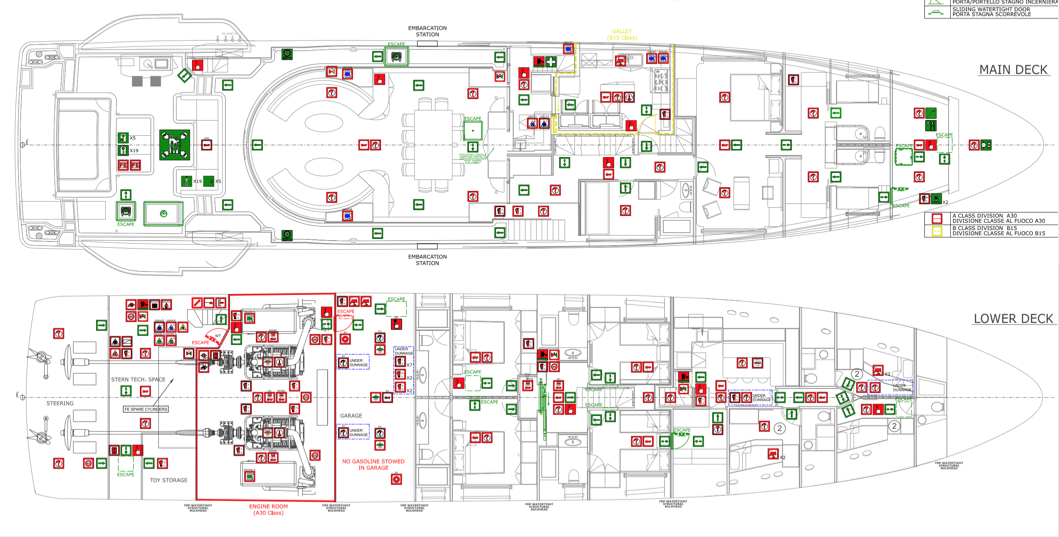
By contrast, the above GA represents a commercial vessel. Fire boundaries for the engine room and galley are highlighted with red and yellow borders respectively. There is still no fixed fire system in the accommodation. There is, however, fire treatment for soft furnishing and hanging material. The conclusion from the risk assessment is that the vessel represents a moderate risk of a fire rapidly spreading throughout the yacht.
In defence of private vessels, there are various means of reducing fire risks. For instance, systems, substances, surveys and so on can be added after the fact to reduce the risks of fires starting in the first place…and yet this doesn’t always happen. Below is a paraphrased version of a discussion between an insurer and a key decision-making stakeholder. The highlighted portions paraphrase the stakeholder's responses to the requests made by the insurer, with further comments from the insurer added afterwards. The aim was to increase the fire safety levels on board the vessel and, therefore, make it insurable. Note that this case is extreme and not representative of general industry standards.
1. A request for a thermal camera
Stakeholder: In boats of a certain size the chief engineer is qualified to conduct high-level thermal inspections of the vessel. For private superyachts under 300t, this isn’t the case. It would be theoretically possible, albeit not desirable, to ask for an annual thermal survey for €6.6k.”
Insurer’s reflection: We are not expecting a thermal survey, we are proposing that a hand-held thermal camera is purchased and that a monthly process is created and enacted for taking photos of the main risk areas such as electrical boxes/point, engine room and so on. Further action is only required in the eventuality that unexpected hotspots are found. Cost €1000.
2. A request that all upholstery fabric will be treated with fire-resistant material
Stakeholder: This is not a requirement from flag.
Insurer’s reflection: With no fixed firefighting system in place for the accommodation areas, we consider this not only good value but a prudent action to protect the owner, their family and any guests. Cost €5,000.
3. A request to conduct a cyber survey
Stakeholder: Cyber surveys are only requested by class and flag for yachts over 500GT
Insurer’s reflection: We don’t request a formal survey for smaller superyachts, but we do ask that they conduct a simple survey (under our guidance) to help them at least understand the issues on board and that the crew undergo some basic training to generate a heightened awareness. Cost €3,000
4. A request for immersion suits in case of an incident
Stakeholder: Again, this is not a requirement for flag or class, nor is it a requirement for the use of the boat.
Insurer’s reflection: If the vessel has no fixed firefighting system in the accommodation, no fire boundaries in the high-risk areas, then a fire is likely to spread quickly. In these cases, the only safe place to go is into the water, at which point they will wish that there were immersion suits onboard.
5. Concluding remarks
Stakeholder: This vessel is running at a high standard according to all necessary requirements on the part of both class and flag. Adding safety equipment is wonderful in theory, but this must be weighed against the defined requirements without further impositions on the part of the industry. The suggestions you presented come to around €20,000, if we were to comply would the insurer be willing to reduce our premium? As far as we are concerned, a risk management survey should be done to ensure the vessel is meeting the requirements for a vessel's size, GT, class, flag etc.
Insurer’s reflection: The superyacht is running at the minimum standard, not at a high level. The total expenditure, if the advice had been followed properly, would have been nearer €10,000, as well as a time investment on the part of the senior team on board, which is an inconsequential fraction of the vessel's overall value. Risk assessment surveys are to confirm the vessel is meeting the required standard, but also to offer simple guidance to help increase the safety and operational levels of the yacht.
As previously stated, this is an extreme example, but it highlights the ways that a determination to meet minimum requirements and avoid additional costs can have a negative impact on the safety of a vessel, regardless of how much it may fly in the face of common sense.
Some readers and some stakeholders will, of course, disagree and it must be said that there are a number of private vessels that do apply common sense, that keep high standards regardless of requirements and run a programme that will ensure that serious fire incidents are unlikely. Nevertheless, incidents occur, whether through human error, systems failure or otherwise, and I can’t imagine that any owner would suggest that the lives of their friends, family, colleagues or crew are worth less than €10,000, which begs the question: Are owners always aware of where minimum standards are implemented and cost-saving measures applied.
NEW: Sign up for SuperyachtNewsweek!
Get the latest weekly news, in-depth reports, intelligence, and strategic insights, delivered directly from The Superyacht Group's editors and market analysts.
Stay at the forefront of the superyacht industry with SuperyachtNewsweek
Click here to become part of The Superyacht Group community, and join us in our mission to make this industry accessible to all, and prosperous for the long-term. We are offering access to the superyacht industry’s most comprehensive and longstanding archive of business-critical information, as well as a comprehensive, real-time superyacht fleet database, for just £10 per month, because we are One Industry with One Mission. Sign up here.
Related news
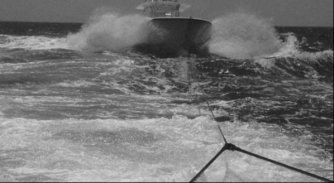
Protecting against tender losses
Why has tow protection for tenders had a slow uptake given the frequency of losses and its low implementation cost?
Technology
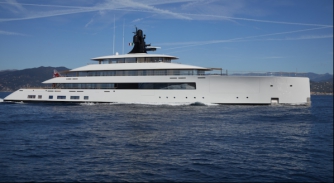
More than a window
We explore a number of ways that glass technology is evolving and consider some of the applications for superyachts
Technology
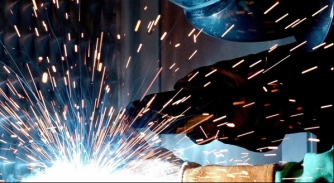
Resetting the lifecycle curve
How can we create a new lifecycle curve with the right kind of investment?
Business
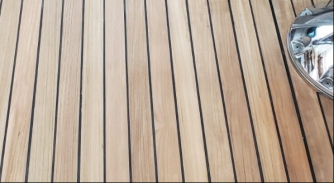
The teak problem
We explore the history of teak to kickstart a series of articles on alternative materials and solutions
Business

Worth their salt
What role can the Salt Battery play in a more sustainable future? Massimino Cavaliere sales & marketing director at FZSONICK explains
Technology

A token gesture
How the tokenisation of physical assets on the blockchain is changing the superyacht transaction landscape
Owner
Related news
Protecting against tender losses
4 years ago
More than a window
4 years ago
Resetting the lifecycle curve
4 years ago
The teak problem
4 years ago
Worth their salt
4 years ago
A token gesture
4 years ago
NEW: Sign up for
SuperyachtNewsweek!
Get the latest weekly news, in-depth reports, intelligence, and strategic insights, delivered directly from The Superyacht Group's editors and market analysts.
Stay at the forefront of the superyacht industry with SuperyachtNewsweek




